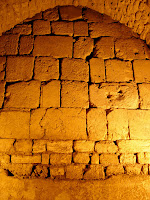COMMENTARY:
The pace has been extremely brisk today, and my back is paying for it. If I realized how rough the trip was going to be, I would not have gone. No one seems to wait for anyone, and at every walking turn, there is an opportunity to get lost; and yet, the agony is well worth it. Many things that I have seen so far are things that no tourist would usually see, and so I am blessed that I am able to see these things. And, although Todd is brutal when it comes to running his program, his knowledge of the sites and events is something that would not be available in a regular tourist oriented tour. He is also, and rightly so, focusing our schedule around Christian events and prophecies. I am also learning that there are very few things here in Jerusalem that I have seen that are directly related to the sites where Jesus was, because I am constantly reminded that in AD 70, Jerusalem was utterly destroyed. And some places that we think certain events may have taken place are not necessarily accurate, because there is more than one theory surrounding the placement of those events, which include the crucifixion and Jesus’ burial. Some of this will be discussed in the places which I visited today.
THE TEMPLE MOUNT AND THE DOME OF THE ROCK:
The Dome of the Rock, unfortunately, is a Muslim Shrine. Non-Moslims are neither allowed inside that site or the Al Aqsa Mosque which is next door. While only Moslim men pray at the mosque, women can pray at the shrine, which is not a mosque. It is sometimes difficult to get up to the Temple Mount, because it is closed on Fridays and Saturdays, rest days for the Moslems and Jews, respectively. All mosques here face South toward Mecca.
Al Aqsa is the third most important Muslim site, because Moslems believe that Mohammed traveled here and then, after he died, it is believed that he ascended to heaven from the Dome of the Rock. There is, however, a second dome called the Dome of the Ascension which some say was the place where Mohammed allegedly ascended. Also just outside of the main entrance is the Dome of the Chain.



Most everything that was built on the Temple Mount has been within the last 1,000 years. The dome was built in 630, and the Al Aqsa Mosque in 731. The grounds, themselves, were probably at the same level as the 1st Century AD.
The King of Jordan was assassinated here, because Moslems thought that he was helping the Israelis. And that, to them is a death offense. From 1947-1967 Jews were not even allowed on the grounds or even at the Western Wall. That changed, of course, after the Israelis won the 67 war and took over the management of Jerusalem. Yet, Israeli authorities and most Israelis, who operate in a secular environment, are content to allow the Moslems control of the Temple Mount. Except for a small faction of protagonists, even most Orthodox Jews are willing to let God take care of the rebuilding of the new Temple.

On the inside of the Dome is inscribed the comment that Moslems should think not that God had a son. Many Orthodox Jews will not even go on the Temple Grounds, for fear of desecrating holy ground. In fact, it is against the law to excavate or even take measurements on the Temple Mount, although the Jewish authorities turned their heads when the underground mosque located next to Al Aqsa called Al Maruani was built and the refuse was dumped in the Kidron Valley. Now, archeologists are going through the rubble and have found some important artifacts, like seals, including the seal of one of the Old Testament kings.
The importance of the Temple Mount to the Moslems is related to the interest that others have in the place. It is interesting to note that Islam , being a daughter religion of Judaism, employed Byzantine Christian Architects to be involved in the design the dome, and its style is similar to the Church of the Holy Sepulcher, except that it is more ornate. odd Bolen, our instructor, thinks that the Dome of the Rock was the place upon which the Holy of Holies was placed, during the first Temple Period. Of course, tradition understands that, as well. The rock is a large outcropping of bedrock, and some say that there is a rectangular area on which the Holy of Hollies would logically be able to be placed. Some traditions suggest that this is also the place where Abraham sacrificed Isaac.
The Temple Mount is located on Mt. Moriah and is referenced In Genesis with respect to Abraham and 2 Chronicles 3:1 with respect to the Temple. The first time that Jesus came to the temple was as a baby. This is referenced in the Bible by the account of Simeon and Anna, who recognized His greatness. Zechariah 9 prophesies Jesus’ triumphant entry into Jerusalem. The following day, Jesus drove the money changers out of the temple, and Todd suggests that in doing so, He was exercising His authority as the Messiah, while at the same time, He is uniting the authorities against Him.


We also looked at the Golden Gate, one of the entrances where worshipers passed.
DAVIDSON CENTER AND THE JERUSALEM ARCHEOLOGICAL PARK:

 At the Southwest edge of the Temple Mount in the Central Valley, a cornerstone and toppled walls were found. The largest wall, which supports the Temple platform, is 1,490’ and is the Western Wall. The wall running North and South is 914’ and is the shortest wall. The walls are Herodian in design with picture frame sculpturing and were alternated long/short (header and stretcher), with a 1” inset from the level below. An engraving on the cornerstone suggested that it was for the place of announcement, where the trumpeter sounds the call to worship on his horn. There is no bonding material used on the blocks.
At the Southwest edge of the Temple Mount in the Central Valley, a cornerstone and toppled walls were found. The largest wall, which supports the Temple platform, is 1,490’ and is the Western Wall. The wall running North and South is 914’ and is the shortest wall. The walls are Herodian in design with picture frame sculpturing and were alternated long/short (header and stretcher), with a 1” inset from the level below. An engraving on the cornerstone suggested that it was for the place of announcement, where the trumpeter sounds the call to worship on his horn. There is no bonding material used on the blocks.
 Jutting out from the wall is the remnant of Robinson’s Arch, an archway that went over the road along the side of the Temple Mount. This is the same North/South Street that may be the way to the newly discovered pool of Siloam.
Jutting out from the wall is the remnant of Robinson’s Arch, an archway that went over the road along the side of the Temple Mount. This is the same North/South Street that may be the way to the newly discovered pool of Siloam.

This place is also used for Bar Mitzvahs, because it is part of the Western Wall, which is the last vestige of the Temple, and on Mondays and Thursdays, the scrolls are brought out to read. The traditional Western Wall does not allow men and women together, so that is why this segment is often used for both Bar Mitzvahs and Bat Mitzvahs.
 RITUAL BATH: This required full immersion and a source of water from heaven (rain water).
RITUAL BATH: This required full immersion and a source of water from heaven (rain water). HULDA GATE: At one time there was both a double and triple gate. The double gate allowed for a 51’ corridor where people entered the Temple through an underground entrance. They would enter on the East side and leave by the West side, unless in mourning. Fred, one of our guides, thinks that the Psalms of Ascent (120 through 135) were recited as the Jews mounted the temple steps. There are 15 steps and 15 landings and 15 ascent psalms. At each landing, he thinks that a psalm was read.




WOHL MUSEUM: We visited a site where three upper class homes had been excavated. Unfortunately, no pictures were permitted.


TOMB OF DAVID:
This tomb, located in the Armenian Quarter is suggested by some traditions to be the tomb of King David. However, David was buried inside the City of David, which does not include that site.

 THE UPPER ROOM (John 14-16): In the same building that was alleged as David’s tomb, a Roman Period floor was discovered at the bottom of a ditch. Also discovered were Jewish/Christian writings which suggested that activities were conducted by Jewish believers after AD 70 (See Acts 12) at the house of Mary, mother of John Mark, the Gospel writer. There is also a biblical account, written by Mark that states that someone in the Garden of Gethsemane, during the betrayal of Jesus, ran away after a sheet had been torn from him. That person was reported to be Joh
THE UPPER ROOM (John 14-16): In the same building that was alleged as David’s tomb, a Roman Period floor was discovered at the bottom of a ditch. Also discovered were Jewish/Christian writings which suggested that activities were conducted by Jewish believers after AD 70 (See Acts 12) at the house of Mary, mother of John Mark, the Gospel writer. There is also a biblical account, written by Mark that states that someone in the Garden of Gethsemane, during the betrayal of Jesus, ran away after a sheet had been torn from him. That person was reported to be Joh n
n  Mark, and there may have been a connection between his presence in the garden and the room from which the disciples had just came from. The actual room, of course, no longer exists. However German Catholic Dormation Abbey, a building from the Crusader period, is now located at that place, which is also the summit of the Western Hill, or what is now known as Mt. Zion. If this place was not the site of that room, it is probable that the actual site was nearby. The roof of that building was used by Jewish people from 1947 to 1967, because that was the closest point that they could get to the Western Wall of the Temple Mount.
Mark, and there may have been a connection between his presence in the garden and the room from which the disciples had just came from. The actual room, of course, no longer exists. However German Catholic Dormation Abbey, a building from the Crusader period, is now located at that place, which is also the summit of the Western Hill, or what is now known as Mt. Zion. If this place was not the site of that room, it is probable that the actual site was nearby. The roof of that building was used by Jewish people from 1947 to 1967, because that was the closest point that they could get to the Western Wall of the Temple Mount.

 WESTERN WALL TUNNEL: This is a passageway built outside the Western Wall that can be used to travel the length of the wall.
WESTERN WALL TUNNEL: This is a passageway built outside the Western Wall that can be used to travel the length of the wall. 





